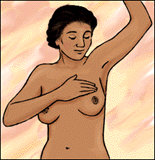
|

|

Health care providers often talk about surviving cancer, or they may use the term remission rather than cure because the disease may recur.
You may use statistics to estimate your chances of cancer coming back. However, statistics are averages based on large numbers of patients. They cannot predict exactly what will happen to you, because no two patients are alike. You should feel free to ask your health care provider about your chance of cancer in the future. Keep in mind that he or she will not know exactly what will happen.
You can help identify any recurrent breast cancer early with regular follow up care - including procedures like breast self-examinations, regular physical exams, and mammograms. Not only is this important from a medical perspective, but it may give you some peace of mind about your health in the future.
Changes in your breast - possible local cancer recurrence:
Changes in the way you feel - possible systemic cancer recurrence:
You should see your health care provider if you notice any changes in your breasts or other parts of your body. The changes may be caused by cancer, or they may be simply be caused by other, less serious problems. One of the greatest challenges in this part of your recovery is to find a balance about how you feel. Every ache and pain does not mean your cancer has come back, but it's important to be cautious about how you feel - without feeling paranoid.
Continue Self Exams
Breast self-exams are recommended once a month to check both the treated area and your other breast. You should report any changes such as lumps, rashes, redness, or swellings to your health care provider right away. A complete physical exam is also needed once a year, which may also include x-rays, mammograms, and blood tests.
Cancer That Returns
If local or invasive breast cancer returns, your treatment will depend upon the location and extent of your recurring cancer, your menopausal status, and general health, and your response to the original treatment. Local treatment may be recommended, consisting of surgery or radiation. Also, some type of systemic therapy is likely to be recommended, such as chemotherapy or hormone therapy.
Early detection and prompt treatment continue to be the best way to keep your body healthy. The earlier breast cancer is found and treated, the better your chances for a complete recovery. To take an active role in early detection of breast cancer, you can:
It may be normal for your breasts to feel lumpy and uneven. Sometimes, your breasts may be swollen and tender, especially right before your menstrual period.
By doing monthly breast self-examinations, you can learn what's normal for your own breasts at this point in your life. You will be more likely to find an unusual change that might be a warning of cancer. You can ask your health care provider how to perform a breast self-examination.
Read on for step-by-step instructions of how to do a Breast Self Exam.
Continue the steps for breast self exams on your remaining breast.
Stand in front of a mirror that is large enough for you to see your breasts clearly.
Step 2 and 3 check for any change in the shape or contour of your breasts. As you do the steps below, you should feel your chest muscles tighten.
Watching closely, clasp your hands behind your head and press your hands forward.
Next, press your hands firmly on your hips and bend slightly forward toward the mirror as you pull your shoulders and your elbows forward.
Raise one arm. Use your fingers of your other hand to check the breast and the surrounding area Ð firmly, carefully, and thoroughly. Some women like to use lotion or powder to help their fingers glide easily over the skin. Other women do this step in the shower with soapy water. Feel for any unusual lump or mass under the skin.
Feel your breast by pressing your fingers in small, overlapping areas about the size of a dime.
To be sure you cover your whole breast, take your time and follow a definite pattern, like circles or lines.
It's important to repeat the last step while you are lying down. Lie flat on your back, with one arm over your head and a pillow or folded towel under your shoulder. This position flattens the breast and makes it easier to check.
With your arm over your head, check each breast and the area around it very carefully by pressing and moving in a repetitive pattern.
If you notice a lump or discharge at any time, contact your health care provider.
Some breast cancers may not be detected by mammography, especially in pre-menopausal women. Therefore, it also is necessary to have regular breast examinations in addition to regular mammograms.
If you've had a lumpectomy, mammograms may be recommended to the treated breast at 6 month intervals for a year or two. Thereafter, mammograms will be recommended every year. Routine mammography should continue at regular intervals for your untreated breast.
If you have breast implants you may or may not need mammography, depending upon whether or not you still have breast tissue left. If you have had breast reconstruction using your own tissue following a mastectomy, mammograms in your reconstructed breast are not necessary.
Other visits may include some or all of the following procedures:
Your health care provider will tell you when to have your first post-treatment exam. Discuss with your provider the plan for your follow-up care. For example, providers often recommend follow-up visits about every 3 to 6 months for several years.
See, this is something I've never been through before. To me it was an invasion, it was an intrusion, and cancer had no right to do this to me. And I could think of a million and one other people that it could have happened to instead of me. But on down the road, I thank the Lord that it happened to me because I felt that as I start to get used to this, I could handle it probably much better than some people that I've known that couldn't handle it. I wouldn't recommend this to happen to my worst enemy. I just wouldn't.
It just never goes away. It's there and it's something that you have to deal with. I go back twice a year to get checked for my mammogram. Every time I get a cold, a headache, or get sick I always think its cancer. I can't help it. That's the way I am.
Now I am a five year survivor and I feel fine. I've had bone scans, will have bone scans every year. Liver scans, chest x-rays, all of these things. They don't hurt, but they do make you feel very good when they're all over with, that you don't have cancer in your body. And that's a lot more than what people walking around in the street can say.
.
I think the follow-up after radiation is important, and I have certainly appreciated the fact that I have seen my radiologist every six months and had a mammogram on that breast every six months. That's been very reassuring. I also see the surgeon's office every six months, and I also see the oncologist every six months. And for a person who wasn't used to seeing medical people at all, its gotten to be kind of a drag.
And being a five-year survivor myself, I guess I feel the one thing that is important when you're diagnosed with cancer is that you seek out a support group and seek out other survivors, because it gives you hope and they understand what you're going through.
Your relationships with people I think become, well they either become much better or much worse. I can't think of any relationships that have become worse. But my relationship with my husband has deepened. We're closer than ever, and this has brought us closer. You have a tendency to tell people more often "I Love You", "I care about you". You have a tendency to do more things for other people. A lot of good things happen.
If you are feeling down and you are feeling depressed, then it's up to you to pick up the phone and call someone from that breast cancer support group or reach for recovery, or whoever you have been dealing with, or even your doctor's office and say "This is really bad. I am really ill, and on top of that I'm really, really depressed. Can I talk to someone in the office?" And they don't say no. They recognize that and they deal with it. So it's important I think to reach out for people.
But I thought about it the other night at the support group. They had a man talk about imagery, and they had us go to Lake Michigan, and I was able to do that quite easily. I thought I probably out to do more meditation. I think it's probably helpful. I found a lot of reasons not to do things that I didn't want to do because of this. I think I used it sometimes, and that's okay, I'm sure. up to Contents of this Page
up to Contents of this Page
There are warning signs of cancer's return that you can continue to check for in your unaffected breast, as well as your treated breast. Recurrent breast cancer can cause one or more symptoms, or it can cause none at all.
 up to Contents of this Page
up to Contents of this Page
Invasive breast cancer is a chronic disease Ð it may come back, and you may have to fight cancer for the rest of your life. Knowing this, you should take necessary precautions that will ensure early detection, if it does in fact return.
 up to Contents of this Page
up to Contents of this Page
Women's breasts come in many sizes and shapes. In addition, your breasts change during your life because of age, monthly menstrual cycles, pregnancy, menopause, or the taking of medications. up to Contents of this Page
up to Contents of this Page
If you have had a mastectomy, run your fingers along your incision and feel to make sure it is flat. Check to be sure that no small bumps are present that are new.
 up to Contents of this Page
up to Contents of this Page

 up to Contents of this Page
up to Contents of this Page

 up to Contents of this Page
up to Contents of this Page

 up to Contents of this Page
up to Contents of this Page

 up to Contents of this Page
up to Contents of this Page

 up to Contents of this Page
up to Contents of this Page
Mammograms (x-rays of the breast) can identify many breast cancers before they can be felt. Every woman who has been diagnosed and treated for breast cancer should have a yearly regular mammogram, unless both breasts have been removed. up to Contents of this Page
up to Contents of this Page
Once your treatment is finished, it's important to have regular follow-up exams. During some visits, your health care provider will simply perform a physical exam that includes looking at your breast tissue, incisions, the chest area, underarms, and neck.
 up to Contents of this Page
up to Contents of this Page
![]() Bernita's Experience
Bernita's Experience
![]() Dorothy's Experience
Dorothy's Experience
![]() Nancy's Experience
Nancy's Experience
![]() Carole's Experience
Carole's Experience
![]() Maggie's Experience
Maggie's Experience
![]() Linda P's Experience
Linda P's Experience
![]() Lucille's Experience
Lucille's Experience
